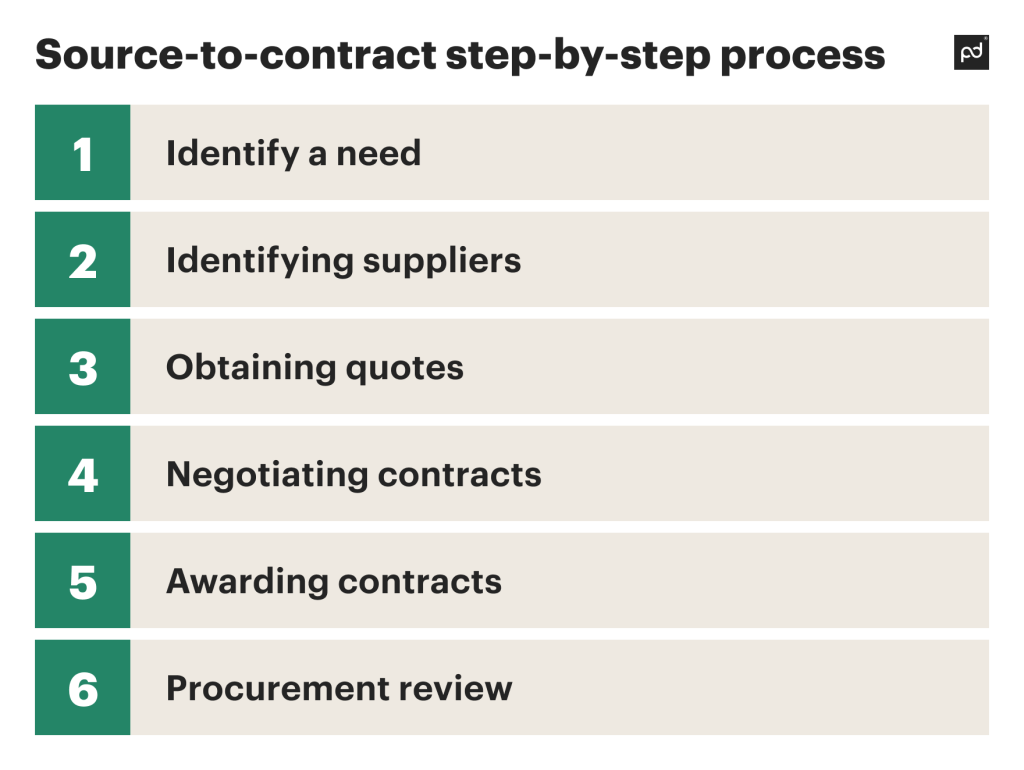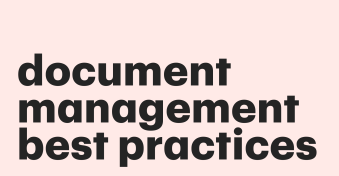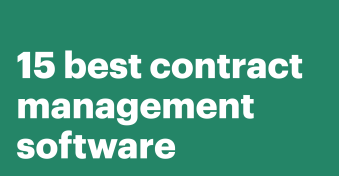Procurement is a vital element of your business processes.
Done correctly, it can result in improved efficiency and savings, allowing you to invest time and resources into other areas of your business.
Essentially, a crucial component of strategic procurement is a process known as “source to contract” (S2C), which we’ll look at in more detail in this article.
Key takeaways
- Effective S2C can help boost the efficiency of the procurement process.
- It can also ensure a secure supply chain and improve compliance, along with facilitating cost-effective relationships.
- Sourcing to contract comprises needs, suppliers, quotes, approval, ordering, receipt, and review.
Source to contract (S2C) definition
“Source to contract” comes under a process called “strategic procurement” and will most likely be handled by your business’ procurement team.
It involves sourcing materials, goods, and services and ensuring optimal terms from suppliers.
For example, it might mean making sure goods are purchased from a reliable supplier at a fair and stable price to suit your budget and economic goals.
Source to contract is a set of sub-processes that a company uses to source and procure products and services. This can include activities such as:
- Identifying and vetting suppliers
- Working out a sourcing strategy
- Obtaining initial and subsequent quotes
- Contract negotiation
- Awarding supplier contracts
The term primarily refers to the part of procurement between sourcing and contract generation i.e. source to contract.
The goal of sourcing to contract is to create and implement effective procurement processes that enhance cost-effectiveness, reliability, and compliance throughout the supply chain.
Source to contract: The benefits for your business
An effective source-to-contract strategy presents a number of key benefits that can make your purchasing processes more efficient.
This is particularly true if you’re using sourcing contract management software to digitize your approach.
Used in conjunction with the right purchasing strategies, specialist source-to-contract software can provide a significant efficiency boost to businesses.
Let’s examine some of the key benefits.
1. Cost reduction
One of the main goals of S2C is sourcing the best prices for products, materials, and services.
Using this method, your team can shop around for the most competitive options and negotiate fair rates with suppliers going forward.
2. Supply chain reliability
Source-to-contract methodologies can also enhance communication between buyers and sellers, resulting in a more reliable supply chain.
Additionally, you’ll take the time to identify suppliers with trustworthy reputations and the ability to fulfill your requirements.
3. Compliance
Another benefit of having a clear process for awarding contracts is enhanced compliance.
Many industries require compliance with certain government and regulatory body rules. S2C can help ensure your supply chain isn’t in breach of any laws or regulations.
4. Greater control
Using a specialist source-to-contract software product allows you to create a streamlined process for negotiating and awarding contracts too.
All documents, processes, and agreements can be stored in one place and securely accessed when necessary.
5. Reduced risk
Source-to-contract procurement strategies can also help you reduce the risk inherent in important business decisions.
With comprehensive supplier vetting and improved compliance, you reduce the potential dangers of working with third parties.
Challenges of source to contract
The biggest challenge with source-to-contract methodologies comes from having lots of individual contracts that need to be continually tracked and updated.
This can be a daunting task, particularly in industries with stringent compliance requirements. It can also be quite research-intensive.
The good news is that contract tracking and management can be made much simpler with the help of reputable software designed for the task, and research can also be streamlined with the right tools to help you.

The source-to-contract process is designed to enhance a company’s procurement strategy and ensure a secure and efficient supply chain.
S2C will look different from business to business, but the basic steps you’ll need to follow are outlined below.
1. Identify a need
Before the S2C process can begin, you need to identify the general and specific needs of each product you require.
What this means is that you need to identify, for example, that your business requires a new telephone system to support its recent expansion. This is a general need.
Specific needs pinpoint what requirements you have for this product in particular.
For example, your new phone system might need messaging capabilities, document storage, and multi-way calling for international conference calls.
Once you’ve identified your specific needs, you can begin reaching out for quotes from suppliers that can deliver on your requirements.
2. Identifying suppliers
Finding suppliers is another crucial step in the S2C process.
This is the point at which you identify suitable parties whose products or services meet the requirements you set out.
You might select a shortlist of suppliers for each product based on:
- The provisional cost
- Their reputation
- Their ability to scale
- Existing contracts with that supplier
At first, this can be time–consuming. However, it can be made faster by implementing a standard procedure that you follow time after time.
Be sure to do your research before selecting a supplier, particularly for a new product or service.
3. Obtaining quotes
This is the stage where you gather quotes from your shortlisted suppliers.
Of course, you’re looking for the contact that will provide you with the best price for the product or service you need — but that’s not all you have to consider.
When getting quotes from potential suppliers, you must also ascertain whether they can fully meet your requirements, what additional services they may be able to provide, and any economies of scale they can offer if your business grows in the future.
Quotes will typically need to be shown to and approved by key stakeholders before you proceed to the contract negotiation stage.
4. Negotiating contracts
Once your quotes have been reviewed and you’ve created a shortlist, it’s time to start negotiating.
This is your opportunity to reach a mutually satisfactory agreement with a third party that builds the foundations for a positive long-term relationship.
Remember, negotiating contracts is about more than just getting the best price.
5. Awarding contracts
It’s time to make it official!
The terms will need to be agreed with all key stakeholders, and then you’ll have to notify your chosen supplier that they’ve been awarded the contract.
Finalizing a contract can take time, so be sure to enact procurement processes well in advance where possible.
6. Procurement review
S2C combines regular procurement processes with strategic sourcing to develop long-term strategies and an efficient supply chain.
However, you’ll need to regularly review it to ensure your approach is as beneficial to your business as possible.
Key areas to review include suppliers (e.g. their ability to continue meeting requirements, industry reputation, and costs) and related processes like contract negotiation.
Source to contract vs. procure to pay
So, how does source to contract differ from procure to pay?
These two are related terms within the world of business procurement — but there are a few key differences.
Procure to pay is a process by which purchasing is integrated with the accounts payable department for increased efficiency.
The steps in a procure-to-pay approach typically look like this:
- Demand-based purchase. The purchasing department makes a purchase based on the needs of the business.
- Approval. Key stakeholders recognize this need and approve the purchase.
- Purchase order. A PO is raised, indicating to the supplier that the order has been placed.
- Items received. The buyer receives the items.
- Invoicing. The accounts payable and purchasing departments collaborate to raise an invoice to the supplier.
Payment. Once the goods are received, the business makes a payment to the supplier.
So, you can see that procure to pay is very similar to source to contract.
The major difference is that the latter involves integrating strategic sourcing processes to ensure longer-term efficiencies (one of many contract best practices implemented in S2C).
Handle all of your contractual needs with PandaDoc
If you’re looking for a way to facilitate an improved source-to-contract process in your business, then know that PandaDoc’s comprehensive contract management software can support you.
From management to generation and compliance, you can streamline your workflows and enhance your processes.
Even the most complex procurement methodologies are made simpler with PandaDoc, which can generate and manage personalized contracts to meet your exact requirements.
Support your procurement team, enhance your processes, and grow your business today with our one-of-a-kind products.


